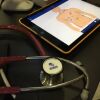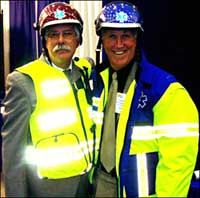 Photo by Dan White Walt Stoy in AllMed AVC Helmet and Hi-Viz Rescue Vest, Baxter Larmon in AVC Helmet and AllMed Ultra-X Coat. |
The picture represents a central theme from two recent first responder conferences: the acknowledgement by EMS care providers of the importance of protecting themselves while out in the field.
Meeting the need
The EMS safety innovations unveiled at EMS Today in Baltimore covered a wide range of technologies and trends that directly carried over to FDIC, held last weekend in Indianapolis.
FDIC is always a huge event, drawing a record 28,000 attendees this year. You really can’t see all the exhibits in one day; it’s that massive.
Included among the notable exhibits were a wealth of new, good-looking high-visibility apparel options, serving as further evidence that the industry is more aware of personal safety and PPE options this year than in years past.
This recognition is most welcome, as our jobs are as dangerous as they’ve ever been. Here is a summary from a NAEMT study regarding the dangers providers face:
|
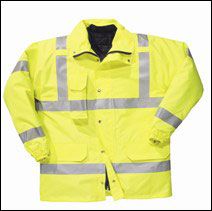 Gerber Outerwear |
The Federal Highway Administration is set to release a new policy for high-visibility safety apparel, which goes into effect this November. According to the rule, “All workers who are within the right-of-way of a Federal-aid highway who are exposed either to traffic or construction equipment within the work area shall wear high-visibility safety apparel.”
Many exhibitors were displaying both ANSI 107-2004 and ANSI 207-2006 compliant apparel. Gerber Outerwear showed off its latest ANSI Class 2 Coats. R & B Fabrications, Viz-Con and many other vendors displayed vests of every conceivable description.
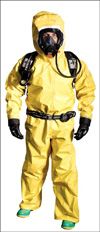 The Tychem BR suit by DuPont |
DuPont displayed its new Tychem BR suit, a lightweight and versatile garment that has been tested to protect the wearer against 250 different chemicals. The company also displayed its ThermoPro Suit, constructed of an innovative new fabric that utilizes proprietary Tychem® chemical barrier technology combined with NOMEX® thermal protective fabric technology. This would be the perfect suit for tactical medics with methamphetamine interdiction teams.
Other safety innovations
Beyond PPE, there were also a slew of products centered on general safety. The new RS Decon is a patented, broad-spectrum skin decontamination product intended to remove or neutralize chemical warfare (CW) agents or T2 toxin from the skin. With a growing concern over the potential for these types of terrorism attacks in the United States, this threat is now a real concern for our emergency first responders.
A growing safety concern has been building over the security of patient retention systems during an ambulance accident. One possible answer presented at FDIC was the Stem Stretcher Mounting System from Italy. This system appears to be more secure than antler mounts and it also has a floating bed suspension that weighs your patient and absorbs road shock and vibration.
For safer pediatric transport, the Safeguard Transport showed obvious advantages. It works on any stretcher and with virtually any size child. The Transport articulates with the head-end of the stretcher while keeping your smallest patients safely secured.
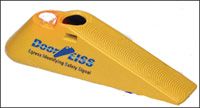 Door EISS |
Many of the latest safety innovations at FDIC were targeted more for firefighters than EMS. One that stood out was the Door EISS Egress Identifying Safety System from Priority One. This brilliantly simple idea is based on what looks like a door wedge. The Door Ease has blinking red LED lights and audible tone when activated. Firefighters confronted with a rescue situation drop the Door EISS units like crumbs on the way in so that the devices provide a trail to follow on the way out.
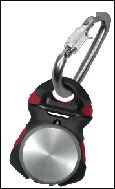 The ROC Vertical Rescue System |
Another outstanding product on display was the ROC Vertical Rescue System. The ROC is a self-contained emergency descent system for rapid self-extrication. It’s compact and convenient, and virtually hands free.
One of the most exciting safety products at the conference was The Last Chance Filter, a small device that converts CO to CO2 in order to buy you extra time should you run out of air or have an SCBA failure. The small device weighs less than a pound, measures a compact 3’ x 5’, and snaps onto most SCBA’s in seconds. This little product could easily save your life.
Several companies showed improvements in emergency lighting. Pelican products demonstrated its new Pelican 9450 RALS Remote Area Lighting System. It combines a tough 1510 Pelican Case with sixteen one-watt Luxeon LEDs. It assembles in minutes and the aluminum pole mount extends to a height of 83 inches to provide 640 lumens of light for any area.
Airstar displayed its Airstar Lighting Balloons, super powerful elevated lights that provide glare-free illumination of a large area. FoxFury demonstrated its latest super-powerful LED torches. The Hammerhead is a solid and compact 320 Lumen LED Flashlight, and its 20 LED Command Series headlamps offer powerful hands-free illumination.
From better ways to see to better ways to be seen — FDIC had it all in terms of on-duty safety products.












